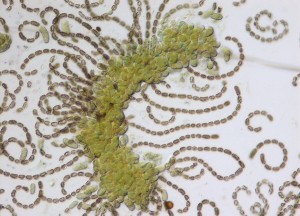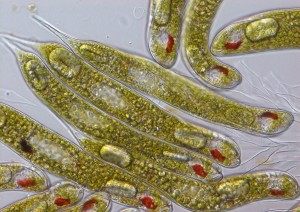by Karl Bruun, Nostoca Algae Laboratory
Algae, a vital group of bacteria and plants in aquatic ecosystems, are an important component of biological monitoring programs for evaluating water quality. They are suited to water quality assessment because of their nutrient needs, rapid reproduction rate, and very short life cycle. Algae are valuable indicators of ecosystem conditions because they respond quickly both in species composition and densities to a wide range of water conditions due to changes in water chemistry. For example, increases in water acidity due to acid-forming chemicals that influence lake pH levels, as well as heavy metals discharged from industrial areas, affect the composition of genera that are able to tolerate these conditions.
Of primary importance from an ecological and public health perspective is the abundance of nutrients containing nitrogen (N) and phosphorus (P) that flow into lakes, reservoirs, streams and rivers resulting in eutrophic conditions (USEPA). The N:P ratio often determines which algae genera are dominant, present or absent in these nutrient-affected water bodies. Sources of the inorganic compounds that contain these elements include household laundry detergents, commercial fertilizers used for lawns and agriculture, and stormwater runoff, along with organic pollution from sewage-related sources including leaky septic tanks and livestock waste. Lakes and reservoirs that receive these sources of pollution periodically, or chronically, display high densities of algae growth resulting in blooms of nuisance and/or toxin-producing genera.
Microscopic analysis of water samples collected from lakes, streams and other bodies determines the diversity and density of algal species and provides potentially useful early warning signs of deteriorating conditions.
Cyanobacteria (blue-green algae)
 In lakes and reservoirs, symptoms of eutrophic situations are the late summer cyanobacteria surface blooms that occur when the water is thermally stratified, sunlight intensity is high, there is a period of mild weather (low turbulence and calm winds) and the N:P ratio is low. Eutrophic lakes displaying blue-green blooms are often shallow and support high densities of cyanobacteria that form unsightly and potentially toxic surface scums.
In lakes and reservoirs, symptoms of eutrophic situations are the late summer cyanobacteria surface blooms that occur when the water is thermally stratified, sunlight intensity is high, there is a period of mild weather (low turbulence and calm winds) and the N:P ratio is low. Eutrophic lakes displaying blue-green blooms are often shallow and support high densities of cyanobacteria that form unsightly and potentially toxic surface scums.
In Washington lakes and reservoirs, these blooms frequently involve a combination of relatively few cyanobacteria genera present at any particular time. Scum-forming blooms often consist of planktonic genera that contain cellular gas vacuoles and heterocytes. Gas vacuoles are responsible for cellular and colonial buoyancy that enables cyanobacteria to out-compete other algae for the available sunlight while heterocytes are responsible for nitrogen fixation. Benthic genera that form mats on the sediment and lack gas vacuoles dislodge in large clumps, float to the top of the water column and also form unsightly, scum-like water conditions.
In high densities, cyanobacteria are an undesirable component of freshwater ecosystems because they can produce hepatotoxins and neurotoxins that are ecological and public health concerns (WADOE). Toxin-producing blooms may disrupt lake food webs by killing fish, birds and zooplankton and can be responsible for hypoxia conditions that follow bloom die-offs. Toxic blooms can also restrict recreation like swimming, fishing and pet-related activities. Additionally, toxins produced from blooms can pose problems for households that get their drinking water from lakes and reservoirs.
To protect human health from exposure to toxic blooms, local and state jurisdictions have implemented programs that monitor lakes for these toxin producers. The WADOE and WADOH ask that lake managers, lake residents and concerned citizens collect bloom samples when they occur and send them in for laboratory analysis. Once identifications and toxin levels are determined, the public is informed and, if necessary, lakes are posted with warning signs or sometimes closed (WADOH).
During laboratory analysis, heterocyte-containing blue-green genera including Dolichospermum (planktonic Anabaena) 1, Aphanizomenon and Gloeotrichia are frequently found in scum samples collected by lake volunteers. The heterocyte-lacking genera Lyngbya, Microcystis, Oscillatoria, Phormidium, Planktothrix, and Woronichinia may also be encountered. Less frequently, other genera like Arthrospira may be responsible for bloom situations. Additionally, cyanobacteria blooms are often accompanied by green algae including Botryococcus, Chlamydomonas, Cladophora, Lepocinclis (some Euglena)1, Mougeotia, Spirogyra and diatoms associated with eutrophic conditions: Navicula, Nitzschia, Melosira and others.
Cyanobacteria Gallery
[nggallery id=1 template=caption]
Greens, Flagellates and Diatoms Gallery
[nggallery id=2 template=caption]
Palmer Indices and the Organic Pollution Index
 Because of their nitrogen-fixing ability, cyanobacteria blooms usually occur when the N:P ratio is low, with phosphorus as the limiting factor for their growth and reproduction. However, when N:P ratios are high, chlorophytes (green algae and flagellates), along with diatoms, are often the dominant genera. In the various Palmer genus indices, groups of green algae and diatom genera are separated into categories that reflect different trophic conditions. These categories include clean water algae, nuisance algae that can clog the screens of intake pipes from drinking water reservoirs, and algae that affect the water’s taste and odor. Another group of algae is associated with municipal sewage treatment plants and is present in large densities in sewage stabilization ponds (lagoons). This group thrives in organically polluted waters rich in nitrogen and phosphorus, and is used as a biological indicator of organic pollution.
Because of their nitrogen-fixing ability, cyanobacteria blooms usually occur when the N:P ratio is low, with phosphorus as the limiting factor for their growth and reproduction. However, when N:P ratios are high, chlorophytes (green algae and flagellates), along with diatoms, are often the dominant genera. In the various Palmer genus indices, groups of green algae and diatom genera are separated into categories that reflect different trophic conditions. These categories include clean water algae, nuisance algae that can clog the screens of intake pipes from drinking water reservoirs, and algae that affect the water’s taste and odor. Another group of algae is associated with municipal sewage treatment plants and is present in large densities in sewage stabilization ponds (lagoons). This group thrives in organically polluted waters rich in nitrogen and phosphorus, and is used as a biological indicator of organic pollution.
Several processes have been developed to treat municipal sewage including trickling filters, activated sludge systems and lagoon systems. Lagoons employ organic pollution-tolerant algae as a biological component that helps change the primary waste into a secondary effluent before releasing it to receiving waters. These algae extract nitrates, ammonia and phosphates present in sewage wastewater and assimilate them into the living algae cell. Pollution algae are often encountered in lakes, streams, reservoirs and rivers influenced by sewage from leaky septic systems, manure, and industrial processes that result in the discharge of organic wastes. This group of algae is also occasionally present in ponds and stormwater retention structures where they may develop large blooms.
The two Palmer Algae Pollution indices (one listed by genera, the other by species) were compiled from reports by 165 authors, and rank the genera/species most often encountered in waters with high rates of organic pollution. The algae are assigned a pollution index value of 1-6. When microscopic analysis shows that these alga genera are present at a density of 50 or more individuals in a 1ml sample, their index value is recorded. Following analysis, the values are totaled. A score of 20 or more is regarded as confirmation of high organic pollution in the waterbody. Scores from 15-19 indicate probable organic pollution. Some of the more common pollution-tolerant genera encountered in Washington water bodies include: Chlamydomonas, Desmodesmus (Scenedesmus with spines)1, Euglena, Lepocinclis (some Euglena and Phacus)1, Nitzschia, Oscillatoria, Pandorina, and Phacus.
Nutrient-related pollution significantly impacts drinking water supplies, aquatic life, and recreational water quality by supporting excessive algae growth. Nutrients reach waterbodies through agricultural and urban runoff, sewage discharges and detergents containing phosphorus. Laboratory microscopic analysis, which reveals the composition and density of the algal flora present in a water body, is an important component of monitoring programs and is valuable in determining diverse trophic conditions. In addition to cyanobacteria, the populations and species diversity of green algae, flagellates and diatoms, which reflect different trophic conditions, are important indicators for evaluating water quality. The indices developed by Palmer are useful analytical tools for assessing non-eutrophic and eutrophic water conditions by categorizing algae that are present or absent in various aquatic environments.
——————–
1A polyphasic approach to algae identifications has recently been employed by algae researchers. This method evaluates algal taxonomy using all known available data and includes biochemical, cytological, ecological, molecular (DNA and RNA analysis) and morphology and morphological variations. The results of implementing this method are the taxonomic reclassifications of genera and species along with the establishment of new genera and species from existing genera.
References
Eaton, A.D., Clesceri, L.S., Rice, E.W. and Greenberg, A.E., editors. 2005. Standard Methods for the Examination of Water and Wastewaters, 21st edition; American Public Health Association, American Water Works Association, Water Environment Federation.
Kling, H.J., Laughinghouse, H.D., Šmarda, J., Komárek, J., Acreman, J., Bruun, K, Watson, S.B., and Chen, F. 2012. A new red colonial Pseudanabaena (Cyanoprokaryota, Oscillatoriales) from North American large lakes. Fottea, Olomouc, 12(2): 327–329. http://fottea.czechphycology.cz/
Jafari, N.G. and Gunale Y.R. 2006. Hydrobiological study of algae of an urban freshwater river, J. Appl. Sci. Environ. Mgt., 10(2): 153-158. http://www.ajol.info/index.php/jasem/article/viewFile/43697/27219
Komárek, J. 2005. The Modern Classification of Cyanoprokaryotes (Cyanobacteria). Oceanological and Hydrobiological Studies Vol. XXXIV, Supplement 3. http://www.oandhs.org/files/290.pdf
Palmer, C. M. 1969. A composite rating of algae tolerating organic pollution. J. Phycology. 5: 78-82.
Palmer, C.M. 1977. Algae and Water Pollution. Municipal Environmental Research Laboratory Office of Research and Development, USEPA EPA/600/9-77-036. http://cfpub.epa.gov/ols/catalog/advanced_display.cfm?&FIELD1=AUTHOR&INPUT1=Lewis%20AND%20Charles%20AND%20A.&TYPE1=ALL&LOGIC1=AND&COLL=&SORTFIELD=YR&SORTORDER=DESC&item_count=24
Raut, K.S., Kachare, S.V., Pathan, T.S., Shinde, S.E., Dabhade, V.F., and Sonawane, D.L. 2010. Utilization of algae as pollution indicators of water quality at Nagapur and Chandapur Dams near Parli. V. Town Dist. Beed Mararashtra, India. International Journal of Current Research. 4: 52-54. http://www.journalcra.com/?q=node/174
USEPA. 2012. Nutrient Pollution Policy and Data http://epa.gov/nandppolicy/
Wacklin, P., Hoffmann, L. and Komárek, J. 2009. Nomenclatural validation of the genetically revised cyanobacterial genus Dolichospermum (Ralfs ex Bornet et Flahault) comb. Nova. http://fottea.czechphycology.cz/_contents/F09-1-2009-05.pdf
WADOE. Washington State Department of Ecology, Algae Control Project http://www.ecy.wa.gov/programs/wq/plants/algae/index.html
WADOH. Washington State Department of Health, Cyanobacteria (Blue-green Algae) http://www.doh.wa.gov/ehp/algae/default.htm










